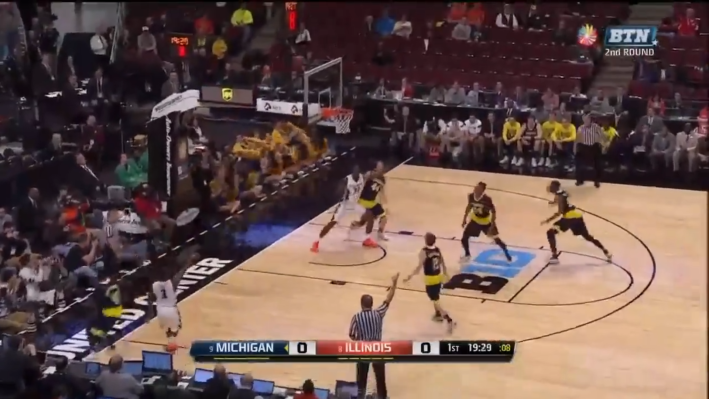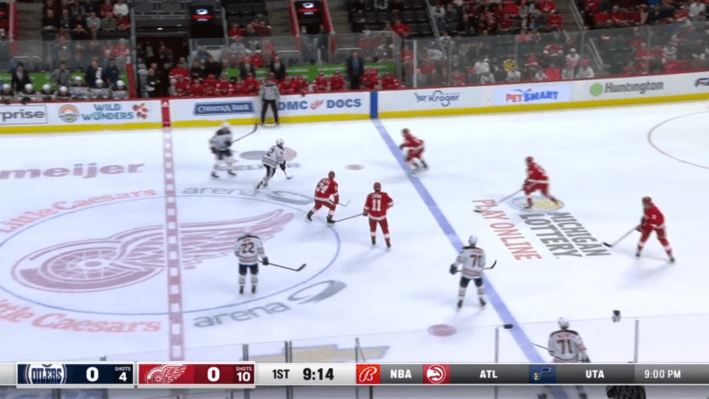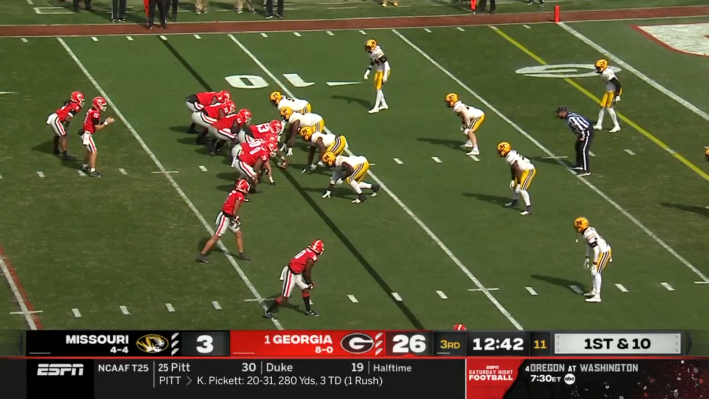It's difficult for me to wrap my head around the fact that, once upon a time, the score of a sporting event was not constantly available to a viewer during every single second it was being broadcast. But each year, as the action in a game takes more and more of a backseat to whatever new fancy graphics the network has designed, the idea of going back to that simpler past holds more and more sway with me.
Wednesday night's college basketball action pushed me even closer to the brink, as the games on the Fox-owned stations sported some hideously large new scorebugs that at their worst covered up huge swaths of the court. Even the less obtrusive shots still left me feeling like I was watching a game while a fan directly in front of me held up a sign just below my line of vision. Take a look at the Buffalo-Michigan situation on Big Ten Network:

First of all, the unnecessary presence of a bottom line pushed the scorebug too high from the get-go. But then, to make matters worse, the combination of the gigantic font for the team names, the need to have logos alongside the names, and the blank space separating these pieces of information all turn the scorebug into the primary attraction, and the actual game you're supposed to be watching into something happening in the background of the score. For an even more horrendous overload, go to the top of this post and check out the still from the Seton Hall game on Fox Sports 1 happening at the same time. For a reprieve from maximalist hell, here's a game on Big Ten Network in 2015:

This is beautifully simple, and it doesn't fight to steal your eye away from what's happening on the court. The details do not even come close to dominating your senses, but they're sitting in a comfortable enough spot if you need them.
And frankly, you probably do need them a lot. I'm not proud of this, but a lifetime of Fox Boxes and ever-present scoreboards has trained me to be instantly angsty whenever technical difficulties, or something like NFL RedZone's war with the Fox graphics, conspire to prevent me from knowing, like, the exact number of seconds left in a period. We're a long, long time past Variety calling these then-new boxes "annoying" in 1994, and the truth is that the scorebugs are now just as much of an inextricable part of the sports broadcast experience as announcers or replays.
But even if the score and time will never and honestly probably should never go away, I could do without all the extra bells and whistles clogging up the screen. Shots on goal? Get it outta here. Pitch count? No way, Jose. The QB's current stats? I can look those up myself, thank you very much. Personally, I believe that anything that does not directly assist me in understanding the current game situation can take a hike, and certainly anything that's not pertinent to the game at all needs to take a long walk off a short pier.
Bally Sports, ever since they replaced the regional Fox channels earlier this year, has been a serious offender on this front, filling up half their scorebug with an endless stream of updates from irrelevant places. Who in the hell is watching the Edmonton Oilers play the Detroit Red Wings that needs to know a Hawks-Jazz game will be taking place later that night? Get it the heck off my screen!

ESPN, too, isn't any better. During Pistons-Rockets on Wednesday, when a massive section of their too-big NBA scorebug wasn't keeping a running total of Cade Cunningham and Jalen Green's point totals on the night—don't need it—it was waving its arms and shouting at you, "Hey, hey! You like basketball? Well stop paying attention to this basketball and think about the future basketball coming up next!"

The bottom line, when it's around, makes things even worse. There was once a time, before the age of smartphones, when the bottom line served a meaningful purpose in a sports fan's life, doling out scores and news at regular intervals that would otherwise be inaccessible to the average fan. But nowadays, when I can type "knckis scoer" into my phone and immediately see that they lost to the Bucks on Wednesday, the bottom line is an archaic remnant of a long-over era, and its presence today is more of a burden on a viewer's eyes than an asset. Check out how ridiculous the ESPN broadcast experience looked with it on Saturday afternoon:

See the guy whose helmet is just barely peeking out above the time remaining? He threw a key block on the touchdown that this play became, and a viewer wouldn't have even been aware of his existence as the ball was snapped. She would, however, know very well that Oregon was set to play Washington in five-and-a-half hours, and isn't that more important?
To a network, it is. While in their infancy the scorebug and the bottom line could easily be positioned as a service to the viewer—some suits even worried when it gained traction that giving away the score and time would encourage more frequent channel-changing—today it holds more value as a vehicle for advertisements than for useful info. Bally's Corporation, the gambling company that has partnered with Sinclair on these stations, likely knows that Detroiters don't really care about Hawks-Jazz, but it has a vested interest in keeping them aware of as many sporting events as possible in order to encourage them to potentially place more bets. ESPN should know that anyone specifically interested in watching Oregon-Washington or Heat-Lakers will already be aware of when it's taking place, but encouraging people to keep their TVs on through the night is more important to them than giving fans the clearest and most complete view of the action.
These on-screen graphics aren't for you anymore. They're for them. And as heartbreaking as it might be, that makes the scorebug our enemy whose growth cannot be allowed to continue.






